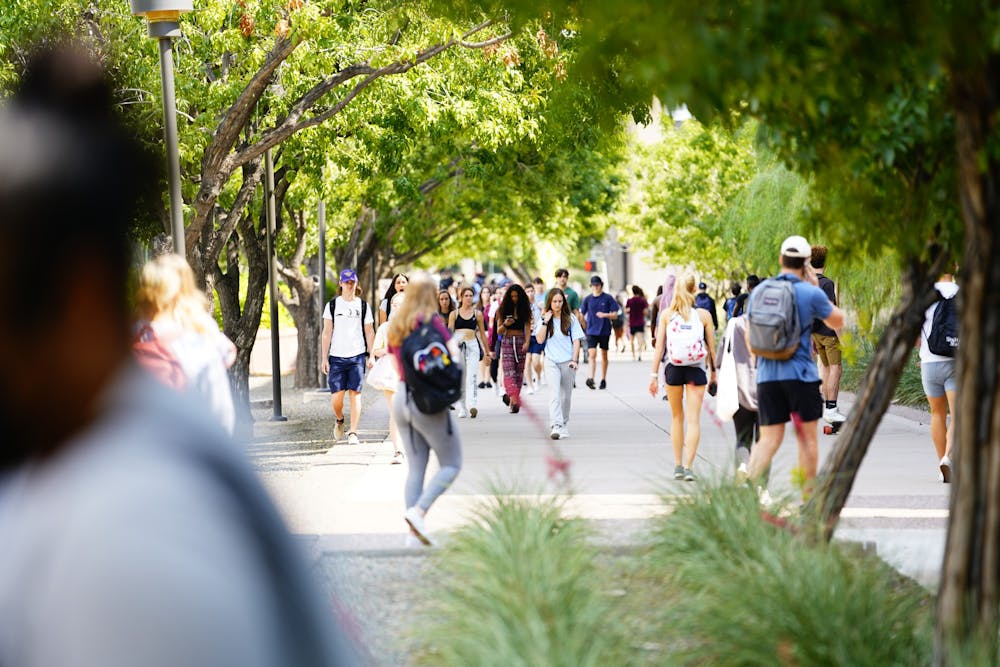ASU students returning from spring break were greeted with a new optional mask policy and no daily health checks, exciting some community members and leaving others nervous to get back to the classroom.
The policy change was announced last Thursday in an email from University Provost Nancy Gonzales and Treasurer and Chief Financial Officer Morgan Olsen. It said masks would be optional on campus with the exception of "designated courses with select required activities, on intercampus shuttles and in healthcare settings."
Prior to the update, masks had been required inside most ASU buildings since August 2021.
Some students on campus said they were more than ready to lose their masks in classrooms and other buildings on campus given the recent decline in cases in Maricopa County. ASU's policy change came a few weeks after the Centers for Disease Control and Prevention announced more lenient guidelines on mask-wearing in low- or medium-risk counties.
Sophomore finance student Cooper Ashton said the change was needed and overdue, given that other universities had already dropped their mask mandates earlier on in the semester.
"I'm vaccinated and I wear masks when it's asked of me, but I feel like we're past that point in all of this," Ashton said. "People who've gotten vaccinated are going to get vaccinated, people who haven't probably aren't going to, and it's not going to go away. So we just have to learn to live with it."
NAU made masks optional on March 7. UA President Robert C. Robbins announced the school would relax its mask mandate on March 21, recommending, but not requiring, masks in most indoor spaces, including classrooms.
READ MORE: Masks, daily health checks to no longer be required on ASU's campuses
Other students were unnerved by the transition and apprehensive to be in close proximity with unmasked students in their classrooms. Junior biomedical sciences student Jueliet Menolascino said students should continue to wear masks in classrooms, especially in shared spaces where distancing is impossible, out of respect for those around them.
"I mask up for me, and I mask up for everybody else, because I don't know people's circumstances, and I don't think it's my place to make that decision for them," she said. "In my opinion, it's not really a hindrance to me, so I continue to wear masks before and after the policy change."
Some students approved of the discontinuation of the Daily Health Checks, the multiple-question quiz that asked students and employees to answer questions on their quarantine status and well-being. Many reported annoyance with the system because it required students to change their myASU password if they failed to complete the daily check.
Sophomore informatics student John Funicello said the Daily Health Checks had no benefit for the ASU community, as it was easy for students to fake results or mark they were off campus.
"It was so pointless," he said. "They (the University) do it so they can say that they're doing something because, the fact is, I don't think it stopped a single person who was actually sick or possibly sick from going to class. It was just a complete waste of time."
Menolascino questioned the timing of the removal of restrictions since many students were traveling and not practicing safe COVID-19 measures during spring break.
"I think it was a very poor choice of timing," Menolascino said. "Last year, they canceled our spring break, and they made it seem as though that choice was to limit the travel and limit the spread. But the cases are pretty similar now to what they were a year ago, and if they made the decision to cancel spring break altogether last year, I don't think it makes much sense to lift the mask mandate now."
Dave Wells, principal lecturer in the College of Integrative Sciences and Arts, said the timing made sense, given new CDC guidelines and significant decline in COVID-19 numbers in the county. Additionally, reported active COVID-19 cases in the ASU community have been declining for eight weeks as of Monday.
"I don't think it was too early, and I don't think it was too late, either. When the CDC changed the metric, Maricopa County moved from being a high-risk area to a medium one," Wells said. "We should generally be following what the science is suggesting, which means if we go up to a higher level, they probably should reimpose the masks."
Reach the reporter at sabuggle@asu.edu and follow @sadie_buggle on Twitter.
Like The State Press on Facebook and follow @statepress on Twitter.

Sadie Buggle is the Editor of the State Press Opinion Desk. This is her third semester working for the State Press after two semesters reporting for the Community and Culture Desk.




